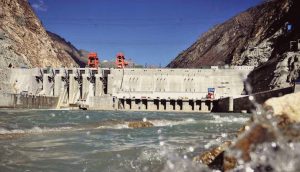China’s rapid growth over the last 30 years has created a vast domestic pool of expertise in infrastructure and construction. However, the growth strategy based on investment in these sectors is showing clear signs of abatement and the transition to a new model based on internal consumption is underway. As a result, companies that are deemed ‘too big to fail’ have been seeking opportunities overseas, many with government backing.
“This is part of President Xi Jinping’s ‘Chinese dream’ and making it come true means that the country will create and share more development opportunities with other countries,” says Antonio Hsiang, director of Chihlee Technology Institute‘s center for Latin American economy and trade studies.
With its enormous bottlenecks in infrastructure, Latin America is seen as an ideal outlet for investment by China’s state-owned and private construction companies. Ambitious and controversial infrastructure projects such as the Nicaragua Canal, a transcontinental railway linking the Atlantic Ocean to the Pacific, high-speed trains and giant hydroelectric plants have been announced with great fanfare in recent years. But they don’t always materialise.
China’s economic influence over Latin America has grown strongly in the last decade, based mainly on the importation of commodities and export of manufactured goods. Investment in infrastructure was always marginal. Until 2010, China had not invested more than US$ 6 billion in Latin-American countries.
According to estimates by the Economic Commission for Latin America and the Caribbean (ECLAC), since 2010, an average of around US$ 10 billion a year is being poured into the region in the form of direct investments. Nevertheless, around 90 percent of this investment relates to the mineral resources sector, notably oil and gas and metals in countries such as Brazil, Venezuela, Peru and Chile.
For Larissa Wachholz, managing partner of investment firm Vallya Investimentos and who lived in China for six years, it’s not the fault of the Chinese that these projects never get off the ground.
“This lack of success seems to me to be more about our own issues with bureaucracy and environmental obstacles,” she says. “When the Chinese come here and say that they’re going to do something, it doesn’t mean that they’re ready to finance the whole construction. They usually have ideas that could make sense,” Wachholz adds. In her opinion, many projects are announced prematurely and generate huge media interest without having first undergone proper viability studies.
At the end of last year, Chinese businessman Wang Jing took the stage alongside Nicaragua’s president Daniel Ortega, to officially announce the start of the construction of an interoceanic canal at a cost of US$ 50 billion. He claimed his company, HKND, could complete the complex project within five years. Despite the extravagant groundbreaking ceremony, work has been postponed until next year amid criticisms of the canal’s environmental impact study.
Transcontinental Railway
In May this year, Chinese premier Li Keqiang, together with Brazilian president Dilma Rousseff, officially announced an agreement to build a US$ 10 billion railway linking Port Açu in Rio de Janeiro to Port Ilo on the coast of Peru, stretching a distance of 5,300 kilometres, despite the technical viability study for the ambitious project still being in its very early stages. Survival, an organization that defends the rights of indigenous and tribal peoples has warned of the dangers to the Amazonian tribes and ecosystems living along the proposed route.
China, the project’s main benefactor, would also provide a workforce, training and construction materials for the railway which, in theory, would save thousands of dollars in transport costs. Commodity exports destined for Asian markets, such as soya, currently travel around Patagonia’s Cape Horn, the southernmost point of the continent.
Matt Ferchen, associate professor of the department of international relations at Tsinghua University in Beijing, believes the transcontinental railway is a highly complex project that necessarily involves local communities, local politicians and many different types of environmental license. “There’s the very real potential for disconnect between the promises and the reality,” Ferchen says.
“It’s very optimistic to think that China can simply show up with plans and money and suddenly create an infrastructure development miracle,” Ferchen says, while also stressing that, despite some improvements, China’s understanding of local business environments still has a long way to go.
According to Elias Marco Khalil Jabbour, a China specialist at the Rio de Janeiro State University, China’s need to invest outside its own borders arises from a surplus of productive capacity. “Their interest in this type of investment is huge. The big problem comes from the institutional conditions imposed by Latin-American countries in order for these works to occur,” he adds.
High-speed trains
Over the last decade China has gained significant expertise in high-speed train construction. However, Ferchen lists one recent example in Mexico – which was set to be the first high-speed link on the continent, linking the capital to the industrial city of Querétaro 210 km away – as just one more unfulfilled Chinese promise in Latin America. But Ferchen says that poor practice on the part of the host government was to blame.
The Mexican government cancelled the US$ 4 billion project after the opposition highlighted the lack of a transparent public tender. The case became emblematic of understanding the importance of domestic politics. “This is a good example of how a Chinese investor can get into deep water over public and legal issues,” Ferchen says.
China Railway Construction Corporation had ‘won’ the right to construct and operate the railway. The Mexican government maintains that it will reopen bidding for the project at a later date.
In Brazil, studies for a high-speed train link connecting São Paulo and Rio de Janeiro have already cost US$ 250 million, without even having gone to tender. According to the latest projections, the project would cost around US$ 7 billion. Originally planned to be operational for the Rio 2016 Olympics, the project has not got off the drawing board. Chinese companies have been involved from the outset. “This enterprise had former president Lula’s full support; he tried to push it forward but there were fundamental problems with it,” says Wachholz.
In Honduras, a train linking Puerto Castilla in the Caribbean state of Colón, with Amapala on Tiger Island in the Pacific’s Gulf of Fonseca, was announced by China Harbour Engineering Company (CHEC), but came to nothing. The 375 kilometre project was seen as crucial to facilitating export logistics in Central America.
“The Chinese want to be responsible for integrating logistics and energy in Latin America. They have the capacity to do that, but they’re going to come across a lot of obstacles,” says Khalil Jabbour.





